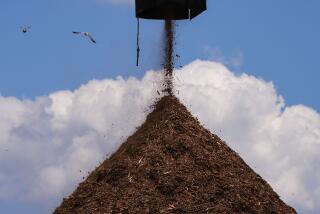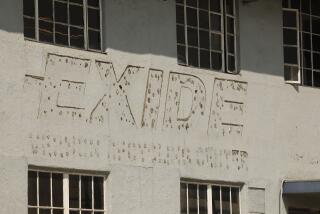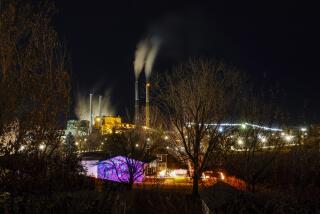Town built on lead weighs the fallout
- Share via
LA OROYA, PERU — Angel Jesus Pacotaype is a child of lead, one of hundreds of youngsters in this Andean town suffering from what a U.S. health study has labeled an “epidemic” of exposure to the toxic metal. The 3-year-old is lethargic and exhibits signs of sluggish development, classic symptoms of lead poisoning.
“We are desperate,” said Luisa Pacotaype, 39, a mother of five who lives with her family in an adobe house in the old part of town, La Oroya Antigua. “We don’t know who to turn to.”
Looming just across the sullied Mantaro River is the poison’s apparent source: La Oroya’s 85-year-old smelter complex, its smokestack a dark sentinel in the mountain sky.
The facility is at the center of a bitter environmental dispute that pits townsfolk against townsfolk and activists against the smelter’s owner, Doe Run Peru, an affiliate of the St. Louis-based Doe Run Resources Corp.
In the process, isolated La Oroya has become the unlikely setting for a fiercely polarizing struggle over U.S. corporate responsibility in the Third World.
On the twisting streets of the Old Town, air laced with sulfur dioxide spewing from the smokestack irritates the eyes, befouls the mouth and stings the lungs. Fine dust coats furniture and clothes, residents say.
In 2006, the Blacksmith Institute, a New York-based environmental advocacy group, named La Oroya among the world’s 10 most-polluted places, a list that includes Chernobyl, Ukraine.
This is a community where parents recite their children’s blood-lead readings the way moms and dads elsewhere recall their kids’ birthdays.
“They said Angel’s lead level was close to 50, but we fear it may be higher,” said his father, Mariano Pacotaype. In children, a measurement one-fifth of Angel’s, 10 micrograms a deciliter, is considered elevated by the World Health Organization and the U.S. Centers for Disease Control and Prevention.
Officials at Doe Run acknowledge that almost every child tested in the Old Town has a blood-lead reading at least double that level.
Peruvian and U.S. activists allege that the smelter’s daily release of lead, arsenic and other toxic substances has stunted childhood development and caused an array of illnesses, including cancer. A St. Louis University research team said La Oroya faces a “daily toxic cocktail” and labeled the situation “an environmental health crisis.”
However, epidemiological and statistical studies definitively linking the emissions to illness are lacking.
“The scientific research needed to demonstrate beyond doubt that Doe Run’s pollution is making people sick costs money, and people in La Oroya don’t have that,” said Hunter Farrell, a U.S. Presbyterian minister in Lima, the Peruvian capital, who has taken up the cause.
Doe Run officials say emissions are down and have never been shown to have harmed anyone. “I am not aware of any case of serious illness that may be attributed to our La Oroya operations,” said spokesman Victor Andres Belaunde.
Critics say Doe Run’s repeated threats to shutter the plant and leave more than 3,000 employees jobless have intimidated Peru’s government.
“Doe Run basically does what it wants here,” said Mayor Cesar A. Gutierrez Revilla, a former chemical engineer at the plant who won office this year pledging to stand up to Doe Run.
Doe Run officials deny bullying anyone. And many residents support the plant because it drives the economy.
“The smelter is needed here,” said Rocio Guadalupe Mejia, 31, a mother of two who heads a community group backed by Doe Run. “There would be no La Oroya without the smelter.”
In March, a complaint was filed with the Washington-based Inter-American Commission on Human Rights demanding “urgent measures” to control pollution.
A bleak terrain
The landscape from the coast up to La Oroya transforms like a series of film cuts: from the drab brown of the arid coastal plain to the pines and rushing streams of the temperate heights and up to snowy Andean passes, inhospitable even to the hardy llama.
But humans have left their mark. Gaping incisions mar hillsides and valleys. Runoff feeds lagoons of garish ochre and vermillion hues.
This is mining country. The veins that drew the Spanish now attract multinational firms, providing a mixed blessing for generations of Peruvians, mostly of indigenous stock.
La Oroya, is a cheerless settlement of 35,000 more than two miles above sea level, dominated by the smokestack, its plume raining emissions on the town and surrounding mountains. The adjacent limestone hillsides are stripped of vegetation. Few homes in the Old Town, founded to house smelter workers, have indoor plumbing.
Vast quantities of mined “concentrates” arrive daily via train and truck, and are cooked to separate lead, copper, zinc, cadmium and other ore, including silver and gold. Most is exported, the lead used in car and transformer batteries and electronics components.
La Oroya is a company town whose inhabitants are caught in a Faustian dilemma: Their livelihoods depend on the very industry that is poisoning them. Many residents work for Doe Run, live in Doe Run-supplied housing and send their young to Doe Run-supported schools. The company logo and its green-and white colors adorn buildings, posters and lunch boxes. Billboards extol Doe Run’s “reforestation” program. Malnourished youths eat at a Doe Run soup kitchen.
“Here the government doesn’t help anyone -- we have to rely on Doe Run,” said Olimpio Villena Blas, a father of three. “In Lima they say our kids are ‘Mongoloids.’ That’s a lie.”
From Missouri to Peru
Doe Run emerged from the old St. Joseph Lead Co., which during the Civil War purchased extensive lead deposits in Missouri. In 1994, a New York-based conglomerate, the Renco Group, acquired Doe Run. Renco’s chief executive is Ira Rennert, known for his junk-bond transactions, his holdings of polluting companies and his lavish Hamptons estate.
By the time Renco took over, Doe Run’s signature smelter in Herculaneum, Mo., was under fire for lead contamination. The area near the smelter along the Mississippi south of St. Louis remains one of the few in the U.S. where lead levels exceed federal Clean Air Act standards.
Under pressure at home, Doe Run expanded abroad, in mineral-rich Peru. In 1997, Doe Run paid $125 million to purchase the complex at La Oroya, which at its inauguration in 1922 was a U.S.-owned plant but was nationalized in the 1970s.
After decades of virtually unchecked pollution, Peru mandated that the new owner reduce contamination.
The most recent Doe Run survey, in 2004, of 788 children 5 or younger showed that more than 90% had blood-lead contents at least double the CDC’s elevated mark. Only one child came in below that level, and five registered levels more than seven times greater.
“For Doe Run to say no one has been harmed by this level of lead exposure is either very naive or very self-serving,” said David Rosner, a public health expert at Columbia University who has studied the lead industry.
Doe Run officials say it is unfair to blame the smelter for illnesses that may be linked to factors such as malnutrition, poor sanitation and parental alcoholism.
The ambiguity has tended to harden divisions in town. “They say their children are short because of the pollution, but how do they know that?” asked Elisabeth Canales, part of a civic group closely allied with Doe Run management. “We are a short race of people, you know.”
In 2005, the Catholic archdiocese invited St. Louis University, a private Jesuit institution, to conduct tests. Despite being denounced in anonymous pamphlets as “vampires,” the researchers were able to gather blood and other samples.
The study found an “epidemic of lead exposure,” along with arsenic, cadmium, antimony and mercury, among other contaminants.
“A place like La Oroya could have existed in the United States about 50 years ago, but not now,” said David Sterling, who heads St. Louis University’s School of Public Health’s division of environmental and occupational health. “There’s so much more regulation, enforcement and the fact that civil society will just not allow these kinds of conditions here anymore. It’s too obvious, too blatant.”
The lack of a definitive link between exposure and illness highlights a paucity of investigation, not of symptoms, said Dr. Hugo Villa Becerra, a neurologist who has practiced here for more than a quarter of a century. Villa and a pediatrician, Dr. Godofredo Pebe, tested 93 babies at the local hospital to determine whether newborns inherited lead from their mothers. All 93 tested positive.
The study had to be conducted clandestinely, Villa said. Hospital management feared antagonizing Doe Run.
Company denials
According to the company’s figures, emissions of lead, arsenic and other hazardous substances have declined by a third or more since the firm bought the plant a decade ago and are now mostly within Peru’s legal limits. (Doe Run won an extension until 2009 to reduce daily discharges of 800 metric tons of sulfur dioxide, a noxious gas that impedes breathing and is an ingredient in acid rain.) The company says it has improved labor practices to reduce workers’ exposure and invested more than $114 million in anti-pollution equipment, including emission controls, a monitoring station and waste-water treatment.
“This facility is in much better shape now than when we arrived,” said spokesman Kaimer Dolmos Vengoa.
But the emissions figures, skeptics note, are drawn from company measurements and exclude “fugitive” discharges that burst frequently from the plant.
The mayor and others say pollution grows as production and profit expand in a bullish global metals market. Doe Run informed the U.S. Securities and Exchange Commission that its net income companywide last year was at least $125 million -- compared with $46 million in 2005, the first year Doe Run topped $1 billion in sales.
In La Oroya, Doe Run sponsors a cleanup campaign that features broom-wielding women sweeping detergent-slicked streets. The company has built public showers and underwrites a preschool for children with the most severe lead exposure. Youngsters recite ditties celebrating hand-washing.
Doe Run officials argue that washing can help reduce oral ingestion of lead. But Sterling, co-coordinator of the St. Louis University study, said inhalation of emissions from the Doe Run plan appears to be “the primary route of exposure.”
Doe Run officials say all emissions should be within legal limits by 2009. But critics are skeptical, arguing that only independent health studies, monitoring and international pressure will force change.
“No community should be subjected to a choice between good health and a good job,” said Fernando Serrano, who headed the St. Louis University research team and returned to Peru last month to arrange for new environmental monitoring.
“That is not a choice that anyone should have to make in these times.”
Andres D’Alessandro in The Times’ Buenos Aires Bureau and special correspondent Adriana Leon in Lima contributed to this report.
More to Read
Sign up for Essential California
The most important California stories and recommendations in your inbox every morning.
You may occasionally receive promotional content from the Los Angeles Times.










